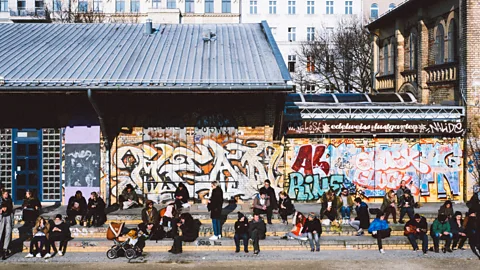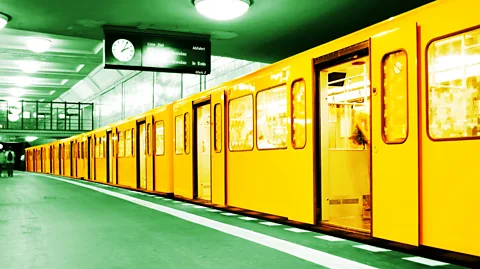Berlin's beloved (and loathed) local dialect
 Adam Kuylenstierna/Getty Images
Adam Kuylenstierna/Getty ImagesBerliners have a reputation for being generally cold, outspoken and rude. It's lovingly called the "Berliner Schnauze", and how you feel about it depends on your perspective.
It was the height of the Covid-19 pandemic when a message came through to my Berlin apartment building's WhatsApp group. It was a video from our neighbour, filming his feet – complete with black socks slipped into a pair of Adidas sandals – as he stomped on a couple of cardboard boxes.
"Cardboard box made small in five seconds," read the caption in German, ive-aggressively punctuated with a kissy face emoji. "If I can do it, so can you."
Berliners generally have a reputation for being cold, outspoken and blunt. This modus operandi is cheekily (or fearfully) called the Berliner Schnauze, literally the "Berliner Snout". It plays off a need for order, an assumption that everyone else is doing something wrong, followed by a brash correction of the behaviour.
Victims of the Berliner Schnauze are usually ersby, getting told off for something they didn't realise they were doing wrong. In our case, it was triggered by the recycling bins overflowing at the apartment building. Others have experienced it on the U-Bahn when they were too hasty getting on and someone barked, "Erst raus dann rein!" ("First out, then in!"). Whatever the case may be, the Berliner Schnauze strikes without warning, usually unprovoked, delivering a brutal level of honesty you never asked for.
 totalpics/Getty Images
totalpics/Getty ImagesOn paper, Berliner Schnauze is simply a dialect of German spoken in and around Berlin. In reality, it's a visceral dialect merged with working-class attitude and influences from French and Yiddish that can be as polarising as it is varied.
Dr Peter Rosenberg, a West Berlin-born linguist whose familiarity with Berliner Schnauze comes from years of study and lived experience, describes it as a "schlagfertig", or quick-witted linguistic game. He says that it's the colloquial language of Berlin – the spark behind a comment or the way you respond to a situation.
Sure, there are differences in pronunciation, grammar and syntax between Berliner Schnauze and Hochdeutsch, or High German (the standard German spoken throughout the country). For example, the Berliner Schnauze uses a "j" where High German uses a "g". So gut (good) becomes jut. But most don't think about grammar and syntax when it comes to Berliner Schnauze. It's an attitude that's entirely based on a situation.
"In a certain sense, the Berliner Schnauze refers to taking advantage of the comedic potential of any given situation, and occasionally, at the expense of the conversation partner," Rosenberg said. "This is where the misunderstanding comes from outsiders."
Despite the cultural confusion, Berliner Schnauze has been influenced by foreigners and minority cultures for centuries.
Descriptions of Berliner Schnauze increased in the 19th Century as High German grew in usage. According to Rosenberg, Berliner Schnauze was lambasted as a primitive form of language along with other German dialects like Niederdeutsch, or Low German. The criticisms were varied, and critics played up the supposed rough nature of Berliners. During the Berlin Wall era, Berliner Schnauze was more common in Communist East Berlin, seen by many in the upper echelons of West Berlin society as a language of the underclass.
 Image Source/Getty Images
Image Source/Getty ImagesBut Berliner Schnauze wasn't born from isolation. Rosenberg names a number of cultural and linguistic influences that have left their mark on the dialect. For instance, Yiddish is well represented in Berliner Schnauze thanks to a historically sizable Jewish community. Glück gehabt (to have luck), for instance, became Mazel gehabt. Meschugge (crazy) and Mischpoke (family) also entered the Berliner Schnauze lexicon through Yiddish.
In addition, French influence came from the time of Napoleon's occupation of Berlin in the early 19th Century. Blümerant (unwell), Kommode (chest of drawers), Toilette (toilet) and Kostüm (costume) can all trace their origin to this period. English, too, is having an influence given its position as the city's second-most spoken language.
Despite the dialect's linguistic pluralism, it hasn't always been well received by outsiders, as Rosenberg suggested. Johann Wolfgang von Goethe, widely regarded as the most influential German-language writer, wrote that Berliners are "an audacious breed of people", adding that "you have to have hair on your teeth and sometimes be a little rough to keep your head above water".
In an informal poll of Twitter s, those from cultures with differing conversational customs agree, tending to misconstrue Berliner Schnauze as overly aggressive or rude. However, Berliners are well aware of Schnauze's notoriety.
Alessandra Morisse, an "Urberlinerin", or someone who grew up in the city, describes Berliner Schnauze as both a dialect and an attitude. "It means being uncomfortably direct, brutally honest and free," she said. "We say things like we mean them, which can be off putting or come across as rude to some, but nine times out of 10, we mean well."
 Tony Smith/Alamy
Tony Smith/AlamySieglinde Tuschy moved to Berlin in 1987 but originally comes from Franconia, a region in south-central tucked within the state of Bavaria. Like Morisse, she describes Berliner Schnauze as both a dialect and the "Lebenseinstellung", or attitude towards life, of born-and-bred Berliners. It's direct, fast, cheeky, funny, and, as Rosenberg said, "schlagfertig" with a certain sharpness, like an "Ohrfeige" – a slap in the face.
"You can't really learn this dialect, even when you've lived here for decades," Tuschy said. "One thing is for sure: With the Berliner Schnauze, you keep non-Berliners at a distance."
At first, she thought the harsh tone of Berliner Schnauze was "terrible", describing it as "a real culture shock". Once at a post office in Berlin's eclectic neighbourhood of Schöneberg, Tuschy found herself waiting in a long line to pick up a package. She says that the post office workers were taking their sweet time, casually chatting with one another over coffee from counter to counter. That's when an indignant older woman yelled from the back, "Wat'n ditte hier, soll ick nu waaten, bis da Leichenwagen kommt">window._taboola = window._taboola || []; _taboola.push({ mode: 'alternating-thumbnails-a', container: 'taboola-below-article', placement: 'Below Article', target_type: 'mix' });
